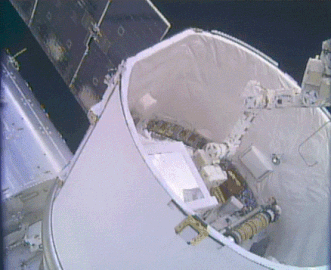 NICER telescope mounted on the Integrated Truss Structure of the International Space Station | |
| Mission type | Neutron star astrophysics |
|---|---|
| Operator | NASA / GSFC / MIT |
| Website | https://heasarc.gsfc.nasa.gov/docs/nicer/ |
| Mission duration | 18 months (planned) 8 years, 4 months and 21 days (in progress) |
| Spacecraft properties | |
| Launch mass | 372 kg (820 lb) [1] |
| Start of mission | |
| Launch date | 3 June 2017, 21:07:38 UTC [2] |
| Rocket | Falcon 9 Full Thrust, B1035.1 |
| Launch site | Kennedy Space Center, LC-39A |
| Contractor | SpaceX |
| Orbital parameters | |
| Reference system | Geocentric orbit |
| Regime | Low Earth orbit |
| Perigee altitude | 402 km (250 mi) |
| Apogee altitude | 407 km (253 mi) |
| Inclination | 51.64° |
| Period | 92.66 minutes |
| Instruments | |
| X-ray Timing Instrument (XTI) | |
 NICER * SEXTANT mission patch Explorer program | |
The Neutron Star Interior Composition Explorer (NICER) is a NASA telescope on the International Space Station, designed and dedicated to the study of the extraordinary gravitational, electromagnetic, and nuclear physics environments embodied by neutron stars, exploring the exotic states of matter where density and pressure are higher than in atomic nuclei. As part of NASA's Explorer program, NICER enabled rotation-resolved spectroscopy of the thermal and non-thermal emissions of neutron stars in the soft X-ray (0.2–12 keV) band with unprecedented sensitivity, probing interior structure, the origins of dynamic phenomena, and the mechanisms that underlie the most powerful cosmic particle accelerators known. [3] NICER achieved these goals by deploying, following the launch, and activation of X-ray timing and spectroscopy instruments. NICER was selected by NASA to proceed to formulation phase in April 2013. [4]
Contents
- Launch
- Science instrument
- X-ray navigation and communication experiments
- XCOM
- Selected results
- Gallery
- See also
- References
- External links
NICER-SEXTANT uses the same instrument to test X-ray timing for positioning and navigation, [5] and MXS is a test of X-ray timing communication. [6] In January 2018, X-ray navigation was demonstrated using NICER on ISS. [7]
In May 2023, NICER's thermal shields developed a leak that allowed stray light to enter the telescope. A repair kit containing specialized patches was delivered to the station by the Cygnus NG-21 resupply mission in August 2024, [8] and were applied by Nick Hague in a January 16, 2025 spacewalk. [9]
The NICER team suspended science observations on June 17, 2025 due to an issue with the motor used to point the telescope. [10]






